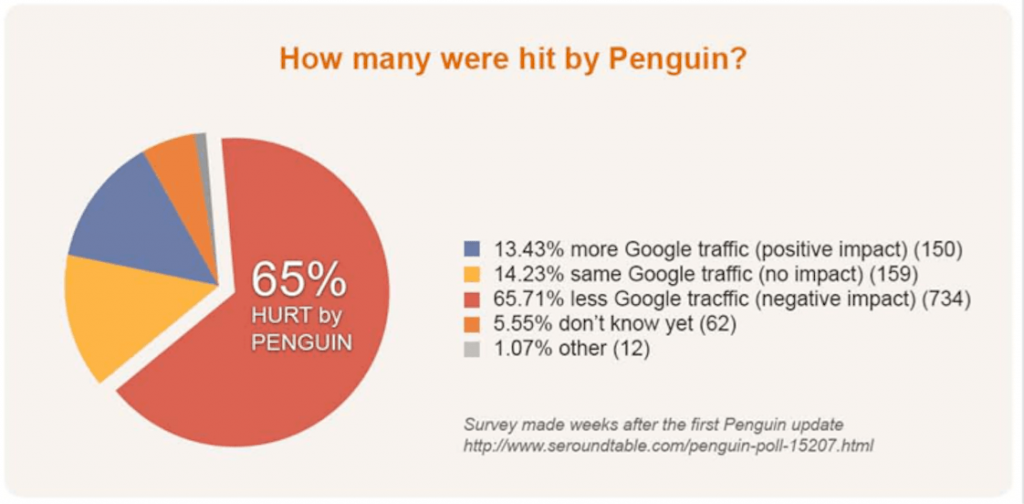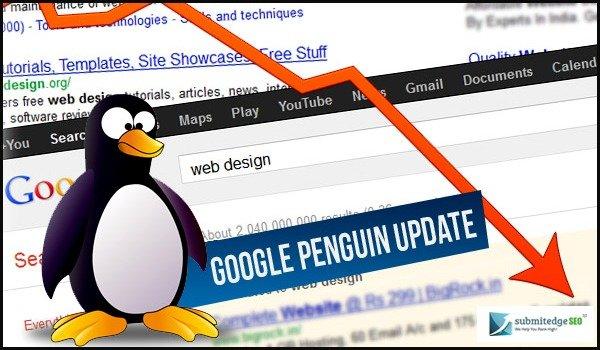Google has rolled out its latest version of Penguin 4.0 which started on 23rd September to completing on 13th October 2016, Search Engine Roundtable reports. This update has had profound effects for online businesses and anyone that practices SEO (search engine optimisation).
What is Penguin 4.0?
This is the latest in Google’s algorithm changes, where the search giant regularly make iterations to its search algorithm and how it interprets search rankings for millions of websites all over the world. The Penguin algorithm is focused specifically on link building practices, which plays a huge role in the ranking factors to get a website higher up on Google.
The idea is that the more quality links you can generate from other websites, the better your rankings will be. However, over time, this has led to search engine marketers and cowboys trying to game Google’s system, by acquiring links from irrelevant sites, through paid-link schemes, incentives or generating numbers of links at an unnatural rate. Google therefore adjusts or ‘refreshes’ its algorithm accordingly to be up-to-date as possible, rewarding SEO-friendly websites and punishing those with faulty practices.
The first Penguin update was released in April 2012, with a further update Penguin 2.0 in May 2013 and Penguin 3.0 in October 2014 (Source: Moz). Sometimes the releases are instant or they slowly progress through the course of the year.
It turns out that 65% of websites featured on Google have been affected by Penguin at one point or another. Whilst sources say that this recent change has only affected 1.0% of sites on Google, this still reflects millions of websites worldwide and thus, has repercussions for companies and their staff.

So what can Penguin do to your website?
Penalise you – Websites can fall several places or pages down Google without warning and in a flash. This can lead to a loss of traffic and income for a business. SEO practitioners need to fix their websites accordingly to overcome this deficit, fixing specific Penguin 4.0 related issues. We discuss below which practices have been punished the most and how to overcome these.
Reward you – With several websites being penalised for poor practice, this new algorithm update could reward your website and business. If other websites are falling down, you could find your website overtaking them and in a much higher position than before, allowing you to reap the rewards of more traffic to your site.
Do nothing – You may have found no difference at all to your website’s rankings despite the update. This reflects strong SEO practices and suggests that you should continue to thrive. Take your SEO guy out for lunch as a thank you.
What SEO practices have been penalised by Penguin?
Google has cracked down on these practices before in previous Penguin updates but now they have become much much stricter. The change in rankings has surprised a lot of SEO practitioners who now have to remove techniques which used to be very effective.
Anchor text – Those websites with too many inbound links with exact match anchor text may suffer from a penalty. This means that if you offer short term loans and have put the link ‘short term loans’ on numerous websites and this makes up the majority of your inbound links, you may find a fall in rankings. This same anchor text applies with internal links that you use to cross reference on your website.
Reciprocal links – Hey, if you link to my website, I will link to yours back. Sounds fair right? Well, some SEO black hatters started doing this on a massive scale and even 10 years ago, this tactic would work really well. But now, this is not something you want, unless it has come from a huge news site like BBC or CNN, in which its OK for them to link to you (great in fact) and OK to link back because its likely that you will tell users where you have been featured or can read the article. It may be worth adding a ‘no follow’ tag to the article you are linking back to.
Footer links – Very common for web designers to add a link to the bottom of their clients website as a accreditation but done on a wide scale, this can initiate a penalty. The reason is simple: lots of links that are not necessarily relevant or have little value. A website about plumbing does not need a link to a web designer on the footer of every page and since the plumbing site may be low value, it looks totally irrelevant.
Directories/paid submissions – Google do not want people to be paying for links on websites or in directories. Paying for an article on the Huffington Post is absolutely fine and a helluva strong link. But sites that are specifically charging money for a listing on their site is simply not in the spirit on SEO which is all about hard-earned links.
What does Penguin 4.0 make better?
Its not all about punishing sites that adopt black-hat or grey-hat SEO, every algorithm change is designed to better the user experience for those using Google and allow Google itself to be more sustainable. After all, Google is crawling the Internet in micro-seconds, so they need a system that can analyse websites in a scalable way.
Real-time changes
Google now promises a much quicker recovery for penalties. Previously, you would maybe have to wait until the next year for another Penguin update, or in this case two years. In fact, I have two clients that benefitted when the new update was released:


Whilst Google say its ‘real-time,’ your recovery may not be instant, but certainly a few days which is a huge improvement.
More granular
This means that a penalty will now only affect the page with the issues and not punish the entire site. So you may not lose as much traffic as before and you should have a better idea where the problem is and be able to fix it.
In conclusion:
- You will find your problems quicker
- You will recover from a penalty faster
How to overcome a Penguin 4.0 penalty
Start with your links. Using Majestic SEO and Google’s Search Console as the best place to start, download your full list of links. Those that look like they are from spammy sites or directories, contact the website to remove them or get rid of them using the Google disavow tool.
Next, find all the anchor text pointing to your site. If you have too many with the exact match anchor text, either contact the website to make the link more like your URL or brand name, or if you think the site is a bit weak, just remove it anyway. If they are internal links, try mix them up a bit instead with things like ‘read more here’ and ‘click here.’
Opt out of those reciprocal link programmes and definitely remove any links that site on the footer of every page of a website.
If you have followed these, you should be on the right track and the next thing to do is go to your Google Search Console and click ‘Fetch as Google’ to speed up the process.
For further reading about SEO, you can read out recent piece on the future of SEO.



